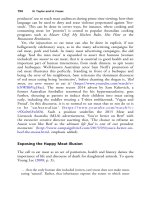The palgrave international handbook of a 476
Bạn đang xem bản rút gọn của tài liệu. Xem và tải ngay bản đầy đủ của tài liệu tại đây (26.5 KB, 1 trang )
478
R. Hediger
DiMarco, drawing from Clutton-Brock, pushes the date of the domestication of the horse back in time to around 4000 BCE, considerably before the
figure of 3000 to 2000 BCE that is often cited (2008, p. 2). But Anthony
pushes the event even further back to around 5000 BCE. Anthony puts this
development in the context of herding other animals, with the use of the
horse enabling people to possess more cattle. Such changes, Anthony supposes, may themselves have inspired new conflicts among peoples as their
relationship to territory, animals, and land shifted (2007, p. 222). It seems at
least possible that the additional powers and facilities won by human partnerships with horses and other animals helped to intensify or even create warfare
as such. In other words, the cooperative relationship between humans and
horses paradoxically helped lead to the traumas and abuses that I explore in
the remainder of this chapter.
Several attributes of horses bear on their domestication and use in war. As
Sandra Swart notes in her history of the horse in South Africa, ‘They were
large enough to be useful, but small enough to be manageable. Most
importantly, they were herd animals, sociable and used to living within a
hierarchy that translated easily into a new hierarchy under human custodianship’ (2010, p. 12). These horse attributes suggest a relatively smooth,
relatively painless transition into domestication for the horse, perhaps, but
again, ironically, that predisposition eventually exposed them to new dangers
in war. Further, Swart notes that horse biology has additional attributes that
make their experiences in war worse than might be guessed:
as prey animals, they reveal illness only if they cannot avoid it. They do
not vocalise pain in the same way that other animals close to human
society—like dogs—do, so it is difficult to tell when a horse is ill, at
least in the early stages.
Combine this fact with the character of their digestive system, which is a
weakness of horse biology, and, as Swart writes, ‘Simple indigestion can
[ . . . ] mean death’. Swart further remarks that war tends to involve a set of
conditions—‘unusual fodder’, unusual or unfamiliar weather, and so on—
that can play on these weaknesses, causing discomfort at best and fatality at
worst (2010, pp. 103–104). Further, horses’ tendency not to respond audibly
to suffering, Swart notes, often facilitates human use of spurs and whips to
direct horse actions, under the misguided theory that a minimal response
from a horse indicates that it does not suffer. Of course, they suffer—silently.
Conditions of war, with their extreme exigency, lend themselves to more
spurs, whips, and the like, meaning horses undergo intensified abuse as a
consequence of their biological background.









